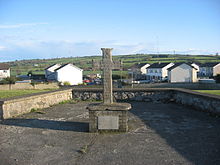Duleek
Duleek ( Irish : Damhlíag - House of Stones) is a village in County Meath in Ireland . It is of historical and ecclesiastical significance, as evidenced by the ruins of a church and a monastery, two high crosses (north and south cross) in the cemetery and some cross slabs .
history
- According to legend, in the 5th century St. Patrick installed Saint Cianán as the head of his first founding church in the Iro Scots Church , which is said to have taken place in Duleek.
- The first monastery was plundered about 10 times by the Vikings between the years 830 and 1149 and again by the Normans in 1171 .
- After the Battle of Clontarf (1014 AD), the fallen High King Brian Boru and his entourage are said to have been laid out in Duleek.
- In the 12th century, Duleek became a bishopric and flourished. The ruins of the Augustinian Abbey (St. Mary's Abbey), one of the largest church ruins in Ireland, testify to this.
The priory
The Augustinians may have come to Duleek before the last destruction of the old monastery. Hugh de Lacy founded a new Augustinian monastery nearby in 1182. The current priory may be part of this monastery. Parts of the arcades of the church can be from the 13th century, the wall of the south aisle from the 14th century; the imposing tower is certainly from the 15th century. The grave of Dr. Cusack, the Catholic Bishop of Meath from 1679 to 1688. Next to it lies Lord Bellew, killed in the Battle of Aughrim in 1691. In the center of the nave is the altar tomb of the Prestons and Plunketts. Some Romanesque fragments have been preserved in the tower . A round tower originally stood in the north. The later square tower was built next to it. After the round tower fell into disrepair (demolished), only its outlines can be seen on the tower wall. In the north of the church there are badly preserved high crosses , probably from the 10th century. One shows the crucifixion and some unidentifiable figures on the west side. The other cross shows the symbols of two evangelists, an eagle and an ox.
St Cianan's Church
The rather insignificant medieval church has a south portal that may have been incorporated into parts of an earlier church. In the northern wall is a large stone with the rough inscription OR DO SCANLAN (a prayer for Scanlan).
Dowdall Cross
The wayside cross that Jennet Dowdal had erected at the beginning of the 17th century is of interest in terms of art history, because it has little in common with the Irish high crosses , but embodies continental influence. Its four stumps protrude only briefly from the square shaft decorated with saints. St. Peter, St. Patrick, St. Cianán and St. Georg are shown. It was repaired in 1810.
Sons and daughters of the place
- Mick McGowan (* 1973), dart player
Web links
Coordinates: 53 ° 39 ′ N , 6 ° 25 ′ W
